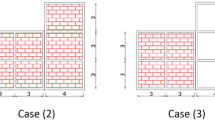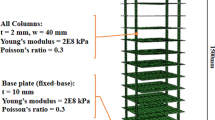Abstract
The present study aims to address the effect of soil − structure interaction (SSI) on the seismic performance of an urban building with a steel frame (hinge/shear connection) and concrete shear walls in the top-down construction method. In the current research, in order to interpret the numerical linear analysis of interaction effects, simulations of soil and structure were conducted in the direct and three-dimensional model using finite element ABAQUS software, and the fixed-base structure model was analyzed on the ABAQUS. To the modeling of an urban structure, all the structural details are taken into account, including the simple connections of beam-to-beam and beam-to-column connections, connections of shear walls to the floor and strip foundations and the top-down method. The site spectrum was founded in the location of the site and three records in three directions were employed to carry out the seismic time history analysis. In this study, some importance features that were scrutinized were base shear forces, torsion and inter-story drifts. The results illustrated that the SSI caused a change in the mode shape of the structure. Thus, the maximum value of the drift in the fixed-based model was formed in the roof, while in the SSI model, it occurs in different stories. The building torsion showed a rise as a result of the SSI, which is a nonconservative value comparing with the fixed-base assumption of the buildings founded on rigid foundations. As well as this, the SSI model experienced a significant decline in the base shear and drift in stories above the ground as compared to the fixed base model. Afterwards, as specified in the seismic building codes, several important seismic parameters, such as base shear, spectral acceleration in the equivalent static analysis, are discussed.



















Similar content being viewed by others
References
ACI 318 Committee (2009), Building code requirements for structural concrete and commentary, American Concrete Institute, Farmington Hills, MI.
AISC (American Institute of Steel Construction). (2005). Seismic provisions for structural steel buildings, AISC 341–05. Chicago: American Institute of Steel Construction.
ASCE-41-17. (2017). ASCE standard: seismic evaluation and retrofit of existing buildings. Reston VA: American Society of Civil Engineers.
ASCE-7-16. (2017). Minimum design loads and associated criteria for buildings and other structures. Reston VA: American Society of Civil Engineers.
ATC 3–06, Applied Technology Council, Structural Engineers Association of California, and National Science Foundation. (1978). Tentative provisions for the development of seismic regulations for buildings: A cooperative effort with the design professions, building code interests, and the research community (Vol. 510). US Department of Commerce, National Bureau of Standards.
Bagheri, M., Jamkhaneh, M. E., & Samali, B. (2018). Effect of seismic soil–pile–structure interaction on mid-and high-rise steel buildings resting on a group of pile foundations. International Journal of Geomechanics, 18(9), 04018103. https://doi.org/10.1061/(ASCE)GM.1943-5622.0001222
Bargi, K. (2000). Principles of earthquake engineering. Tehran, Iran: Tehran University Pub.
Basu, D., & Jain, S. K. (2004). Seismic analysis of asymmetric buildings with flexible floor diaphragms. Journal of Structural Engineering, 130(8), 1169–1176. https://doi.org/10.1061/(ASCE)0733-9445(2004)130:8(1169)
Bazaz, HamidReza Bolouri, Ali Akhtarpour, and Abbas Karamodin (2021), “A study on the effects of piled-raft foundations on the seismic response of a high rise building resting on clayey soil,” Soil Dynamics and Earthquake Engineering 145: 106712, Doi: https://doi.org/10.1016/j.soildyn.2021.106712.
de Borbón, Fernanda, Martín Domizio, Daniel Ambrosini, and Oscar Curadelli (2020), “Influence of various parameters in the seismic soil−structure interaction response of a nuclear power plant,” Engineering Structures 217: 110820, Doi: https://doi.org/10.1016/j.engstruct.2020.110820.
Briaud, J.-L., & Lim, Y. (1997). Soil-nailed wall under piled bridge abutment: Simulation and guidelines. Journal of Geotechnical and Geoenvironmental Engineering, 123(11), 1043–1050. https://doi.org/10.1061/(ASCE)1090-0241(1997)123:11(1043)
Brinkgreve, RBJ, WM Swolfs, E Engin, D Waterman, A Chesaru, PG Bonnier, and V Galavi (2010), PLAXIS 2D 2010, User manual, Plaxis bv.
Canadian Farm Building Code (1995), “Associate Committee on the National Building Code,” National Research Council of Canada: Ottawa, Canada.
Chandler, A. M., & Hutchinson, G. L. (1987a). Code design provisions for torsionally coupled buildings on elastic foundation. Earthquake Engineering & Structural Dynamics, 15(4), 517–536. https://doi.org/10.1002/eqe.4290150407
Chandler, A. M., & Hutchinson, G. L. (1987b). Parametric earthquake response of torsionally coupled buildings with foundation interaction. Soil Dynamics and Earthquake Engineering, 6(3), 138–148. https://doi.org/10.1016/0267-7261(87)90010-8
Chopra, Anil K (2012), Dynamics of structures, Pearson Education Upper Saddle River, NJ.
Desai, C. S., Phan, H. V., & Perumpral, J. V. (1982). Mechanics of three-dimensional soil−structure interaction. Journal of the Engineering Mechanics Division, 108(5), 731–747. https://doi.org/10.1061/JMCEA3.0002867
Duancan, JM (1980), “Strength, stress-strain and bulk modulus parameters for finite element analyses of stresses and movements in soil masses,” Report No, UCB/GT/80–01.
Earthquake Resistant Regulations (1992), “A World List,” International Association for Earthquake Engineering, Tokyo.
El Ganainy, H., & El Naggar, M. H. (2009). Seismic performance of three-dimensional frame structures with underground stories. Soil Dynamics and Earthquake Engineering, 29(9), 1249–1261. https://doi.org/10.1016/j.soildyn.2009.02.003
Falcone, G., Boldini, D., & Amorosi, A. (2018). Site response analysis of an urban area: A multi-dimensional and non-linear approach. Soil Dynamics and Earthquake Engineering, 109, 33–45. https://doi.org/10.1016/j.soildyn.2018.02.026
Far, H, Bijan Samali, and Behzad Fatahi (2010), “Effects of Dynamic Soil−Structure Interaction on Inelastic Behaviour of Mid-Rise Moment Resisting Buildings on Soft Soils,” Australian Earthquake Engineering Society Conference.
Far, Harry (2017), “Advanced computation methods for soil−structure interaction analysis of structures resting on soft soils,” International Journal of Geotechnical Engineering: 1–8, Doi: https://doi.org/10.1080/19386362.2017.1354510.
Fatahi, B., Tabatabaiefar, S., & Samali, B. (2014). Soil−structure interaction vs Site effect for seismic design of tall buildings on soft soil. Geomechanics and Engineering, 6(3), 293–320. https://doi.org/10.12989/gae.2014.6.3.293
FEMA. (1997). NEHRP guidelines for the seismic rehabilitation of buildings, FEMA 273. FEMA.
Forcellini, Davide (2020), “Soil−structure interaction analyses of shallow-founded structures on a potential-liquefiable soil deposit,” Soil Dynamics and Earthquake Engineering 133: 106108, Doi: https://doi.org/10.1016/j.soildyn.2020.106108.
Geo-Slope International (2008), Dynamic Modeling with Quake/W 2007: An Engineering Methodology, Geo-Slope International Ltd, Calgary, Alberta, Canada.
GEO-SLOPE International Ltd (2008), Stress-deformation modeling with SIGMA/W 2007.
Ghandil, M., & Behnamfar, F. (2017). Ductility demands of MRF structures on soft soils considering soil−structure interaction. Soil Dynamics and Earthquake Engineering, 92, 203–214. https://doi.org/10.1016/j.soildyn.2016.09.051
Gutierrez, J. A., & Chopra, A. K. (1978). A substructure method for earthquake analysis of structures including structure-soil interaction. Earthquake Engineering & Structural Dynamics, 6(1), 51–69. https://doi.org/10.1002/eqe.4290060107
Hall, William S, and Giuseppe Oliveto (2003), Boundary element methods for soil−structure interaction, Springer Science & Business Media.
Helwany, S. (2007). Applied soil mechanics with ABAQUS applications. John Wiley & Sons.
Hokmabadi, A. S., & Fatahi, B. (2016). Influence of foundation type on seismic performance of buildings considering soil–structure interaction. International Journal of Structural Stability and Dynamics, 16(08), 1550043. https://doi.org/10.1142/S0219455415500431
Hokmabadi, A. S., Fatahi, B., & Samali, B. (2012). Recording inter-storey drifts of structures in time-history approach for seismic design of building frames. Australian Journal of Structural Engineering, 13(2), 175–179. https://doi.org/10.7158/S11-118.2012.13.2
Ismail, Sahar, Fouad Kaddah, and Wassim Raphael (2018), “Seismic soil structure interaction of a midrise frame structure,” International Congress and Exhibition Sustainable Civil Infrastructures: Innovative Infrastructure Geotechnology, Doi: https://doi.org/10.1007/978-3-030-01923-5_7.
Kaveh, A. (2014). Computational structural analysis and finite element methods. Springer International Publishing.
Kaveh, A., & Farhadmanesh, M. (2019). Optimal seismic design of steel plate shear walls using metaheuristic algorithms. Periodica Polytechnica Civil Engineering, 63(1), 1–17. https://doi.org/10.3311/PPci.12119
Kaveh, A., & Zakian, P. (2014). Optimal seismic design of reinforced concrete shear wall-frame structures. KSCE Journal of Civil Engineering, 18, 2181–2190. https://doi.org/10.1007/s12205-014-0640-x
Kramer, Steven L (1996), “Geotechnical Earthquake Engineering Prentice Hall,” New York.
Liu, J., Yixin, Du., Xiuli, Du., Wang, Z., & Jun, Wu. (2006). 3D viscous-spring artificial boundary in time domain. Earthquake Engineering and Engineering Vibration, 5(1), 93–102. https://doi.org/10.1007/s11803-006-0585-2
Luo, C., Yang, X., Zhan, C., Jin, X., & Ding, Z. (2016). Nonlinear 3D finite element analysis of soil–pile–structure interaction system subjected to horizontal earthquake excitation. Soil Dynamics and Earthquake Engineering, 84, 145–156. https://doi.org/10.1016/j.soildyn.2016.02.005
Mirhashemian, P., Khaji, N., & Shakib, H. (2009). Soil−structure interaction (SSI) analysis using a hybrid spectral element/finite element (SE/FE) approach. Journal of Seismology and Earthquake Engineering, 11(2), 83.
Moghaddas, Navid Hafezy (2009), Seismic microzonation of Mashhad city, geological survey of Iran north east territory (Mashhad, Iran).
Newmark, Nathan M (1969), “Torsion in symmetrical buildings,”.
Rayhani, M. H., & Hesham El Naggar, M. (2008). Numerical modeling of seismic response of rigid foundation on soft soil. International Journal of Geomechanics, 8(6), 336–346. https://doi.org/10.1061/(ASCE)1532-3641(2008)8:6(336)
Shakib, H. (2004). Evaluation of dynamic eccentricity by considering soil–structure interaction: A proposal for seismic design codes. Soil Dynamics and Earthquake Engineering, 24(5), 369–378. https://doi.org/10.1016/j.soildyn.2004.01.003
Sivakumaran, K. S. (1990). Seismic analysis of mono-symmetric multi-storey buildings including foundation interaction. Computers & Structures, 36(1), 99–107. https://doi.org/10.1016/0045-7949(90)90179-6
Srbulov, Milutin (2008), Geotechnical earthquake engineering: simplified analyses with case studies and examples, Vol, 9, Springer Science & Business Media.
Standard 2800 (2005), “Iranian Code of Practice for Seismic Resistant Design of Buildings”, Third Revision, Building and Housing Research Center, Tehran.
Stewart, Jonathan P, Raymond Bolton Seed, and Gregory L Fenves (1998), Empirical evaluation of inertial soil−structure interaction effects, Pacific Earthquake Engineering Research Center.
Tabatabaiefar, H. R., Fatahi, S. B., & Samali, B. (2014). An empirical relationship to determine lateral seismic response of mid-rise building frames under influence of soil–structure interaction. The Structural Design of Tall and Special Buildings, 23(7), 526–548. https://doi.org/10.1002/tal.1058
Tabatabaiefar, H. R., & Mansoury, B. (2016). Detail design, building and commissioning of tall building structural models for experimental shaking table tests. The Structural Design of Tall and Special Buildings, 25(8), 357–374. https://doi.org/10.1002/tal.1262
Tabatabaiefar, H. R., & Massumi, A. (2010). A simplified method to determine seismic responses of reinforced concrete moment resisting building frames under influence of soil–structure interaction. Soil Dynamics and Earthquake Engineering, 30(11), 1259–1267. https://doi.org/10.1016/j.soildyn.2010.05.008
Tabatabaiefar, S. H., Reza, B. F., & Samali, B. (2014). Numerical and experimental investigations on seismic response of building frames under influence of soil−structure interaction. Advances in Structural Engineering, 17(1), 109–130. https://doi.org/10.1260/1369-4332.17.1.109
Venanzi, I., Salciarini, D., & Tamagnini, C. (2014). The effect of soil–foundation–structure interaction on the wind-induced response of tall buildings. Engineering Structures, 79, 117–130. https://doi.org/10.1016/j.engstruct.2014.08.002
Vicencio, Felipe, and Nicholas A Alexander (2020), “Method to evaluate the dynamic structure−soil−structure interaction of 3-D buildings arrangement due to seismic excitation,” Soil Dynamics and Earthquake Engineering: 106494, Doi: https://doi.org/10.1016/j.soildyn.2020.106494.
Wolf, John (1985), Dynamic soil−structure interaction, Vol, LCH-BOOK-2008–039: Prentice Hall, Inc.
Yang, J., Li, J. B., & Lin, G. (2006). A simple approach to integration of acceleration data for dynamic soil–structure interaction analysis. Soil Dynamics and Earthquake Engineering, 26(8), 725–734. https://doi.org/10.1016/j.soildyn.2005.12.011
Yeganeh, N., Bazaz, J. B., & Akhtarpour, A. (2015). Seismic analysis of the soil–structure interaction for a high rise building adjacent to deep excavation. Soil Dynamics and Earthquake Engineering, 79, 149–170. https://doi.org/10.1016/j.soildyn.2015.08.013
Yue, Mao-guang, and Ya-yong Wang (2009), “Soil−structure interaction of high-rise building resting on soft soil,” The Electronic Journal of Geotechnical Engineering, ejge.
Zakian, P., & Kaveh, A. (2020). Topology optimization of shear wall structures under seismic loading. Earthquake Engineering and Engineering Vibration, 19, 105–116. https://doi.org/10.1007/s11803-020-0550-5
Funding
No funding was received to authors with the preparation of this manuscript.
Author information
Authors and Affiliations
Contributions
Ali Akhtarpour conceived of the presented idea. Ali Akhtarpour and Mohammad Amin Mohammadyar developed the theory and performed the computations. Mohammad Amin Mohammadyar performed the analytic calculations and performed the numerical simulations. Mohammad Amin Mohammadyar verified the numerical methods. Ali Akhtarpour supervised the project. All authors wrote the main manuscript Mohammad Amin Mohammadyar prepared figures. All authors discussed the results and contributed to the final manuscript.
Corresponding author
Ethics declarations
Conflict of interest
The authors have no conflicts of interest to declare that are relevant to the content of this article.
Additional information
Publisher's Note
Springer Nature remains neutral with regard to jurisdictional claims in published maps and institutional affiliations.
Rights and permissions
Springer Nature or its licensor (e.g. a society or other partner) holds exclusive rights to this article under a publishing agreement with the author(s) or other rightsholder(s); author self-archiving of the accepted manuscript version of this article is solely governed by the terms of such publishing agreement and applicable law.
About this article
Cite this article
Mohammadyar, M.A., Akhtarpour, A. A study on the seismic soil − structure interaction of a concrete shear wall − steel frame building system with underground stories. Asian J Civ Eng 24, 2609–2627 (2023). https://doi.org/10.1007/s42107-023-00667-5
Received:
Accepted:
Published:
Issue Date:
DOI: https://doi.org/10.1007/s42107-023-00667-5




